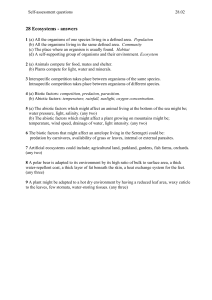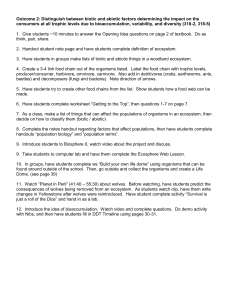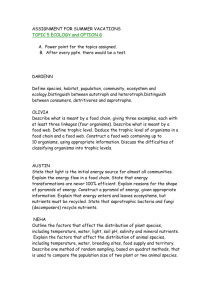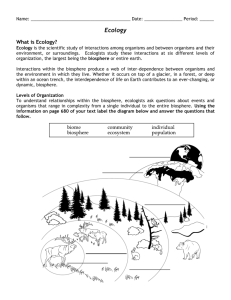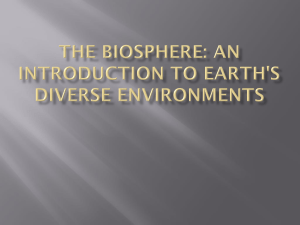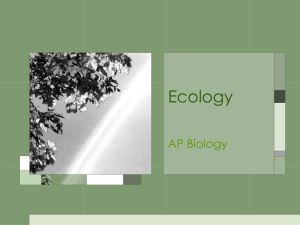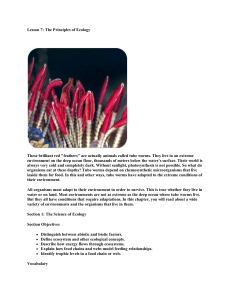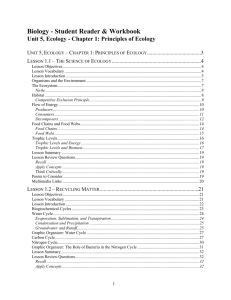Exam 1 Q4 Review Sheet 4/12/11
advertisement
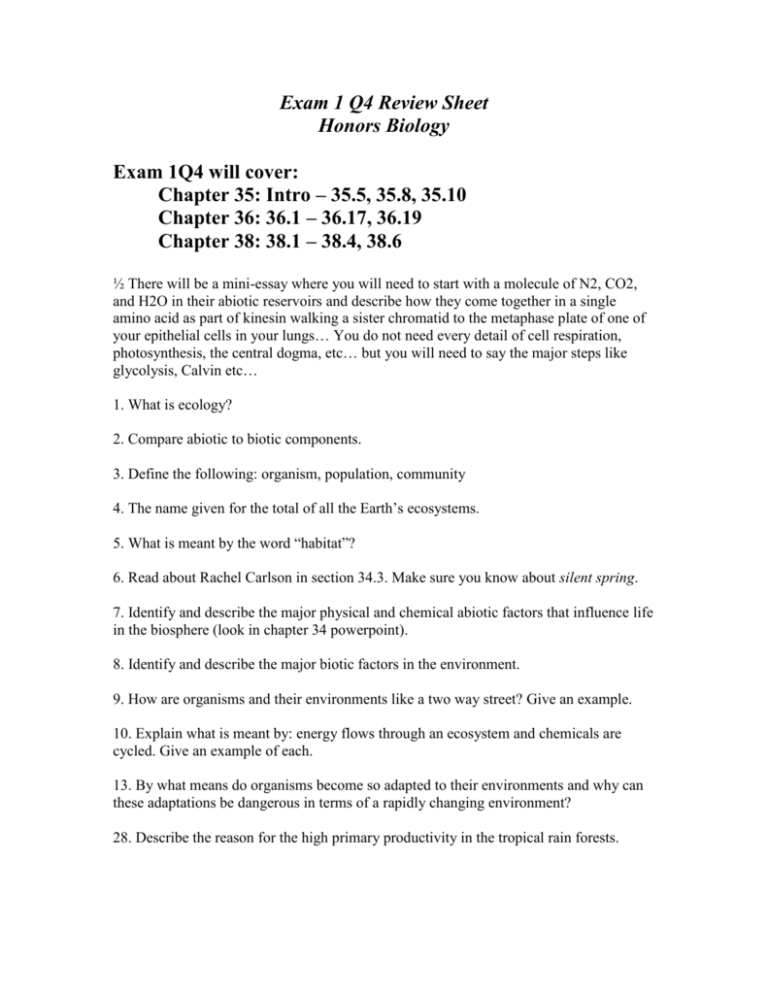
Exam 1 Q4 Review Sheet Honors Biology Exam 1Q4 will cover: Chapter 35: Intro – 35.5, 35.8, 35.10 Chapter 36: 36.1 – 36.17, 36.19 Chapter 38: 38.1 – 38.4, 38.6 ½ There will be a mini-essay where you will need to start with a molecule of N2, CO2, and H2O in their abiotic reservoirs and describe how they come together in a single amino acid as part of kinesin walking a sister chromatid to the metaphase plate of one of your epithelial cells in your lungs… You do not need every detail of cell respiration, photosynthesis, the central dogma, etc… but you will need to say the major steps like glycolysis, Calvin etc… 1. What is ecology? 2. Compare abiotic to biotic components. 3. Define the following: organism, population, community 4. The name given for the total of all the Earth’s ecosystems. 5. What is meant by the word “habitat”? 6. Read about Rachel Carlson in section 34.3. Make sure you know about silent spring. 7. Identify and describe the major physical and chemical abiotic factors that influence life in the biosphere (look in chapter 34 powerpoint). 8. Identify and describe the major biotic factors in the environment. 9. How are organisms and their environments like a two way street? Give an example. 10. Explain what is meant by: energy flows through an ecosystem and chemicals are cycled. Give an example of each. 13. By what means do organisms become so adapted to their environments and why can these adaptations be dangerous in terms of a rapidly changing environment? 28. Describe the reason for the high primary productivity in the tropical rain forests. 29. Deforestation of the tropical forests is occurring at an alarming rate. Explain why farming these regions is futile. Why does it matter that humans are destroying these forests? READ SECTION 34.11 33. Describe the significance of the Great Ocean Conveyor Belt and why might its disruption caused by the melting of polar ice caps via global warming cause dramatic climate changes on Earth like an ice age? 34. Phytoplankton are the main producers of aquatic ecosystems. What types of organisms belong to this group and why are they called phytoplankton? What about the main producers on land? 35. What is an estuary and give an example. Describe why estuaries are one of the most productive biomes on Earth. What is meant by “brackish water”? 39. Where do organisms living in the benthic, aphotic zone get there carbon source and energy source if they are not part of a vent community? 40. What does the term “marine snow” mean? 42. Where do organisms at hydrothermal vent communities get there carbon and energy? 43. What is coral and why does coral need to be in shallow, crystal clear waters? What phylum does coral belong to? 44. Discuss the human impact on aquatic biomes (overfishing, pollution like oil spills, etc…). 45. Describe the process of biomagnification in detail. What impact does this have on humans? How does it relate to DDT? What is DDT and how did it end up in the environment? 48. Define population ecology. Why is it important to study populations? 49. Compare the exponential growth model to the logistic growth model and give examples of each. 50. Identify the carrying capacity in figure 35.3B. In fact, explain this entire logistic growth curve in terms of why it starts slow, speeds up and then levels off. 51. What determines the carrying capacity of a population? 52. Explain why you might hypothesize that no population fits either model exactly. 53. What did Thomas Malthus say about population growth? 54. Identify and describe all of the biotic and abiotic population limiting factors discussed in class and give examples of each. 55. One biotic population limiting factor is space. We learned that organisms tend to disperse in different patterns. Identify and describe these patterns and give real life examples of each. 56. Explain boom-and-bust cycles observed in many predator-prey systems. 57. Read 35.8 about the exponential growth of the human population and ecological footprints – expect 1 question 58. Read 35.10 – Describe the practice and purpose of renewable resource management – expect 1 question. 59. Identify the characteristics of a community. 60. Compare interspecific to intraspecific competition. 60. In class we learned that interspecific competition, predation and symbiotic relationships are all interactions between populations in communities. Define each and give specific examples. 61. Identify the three types of symbiotic relationships and give real world examples of each. 62. Define a keystone species. Identify a real life example and explain why this is an example. 63. Describe the various ways that plants and animals protect themselves against predation. 64. Predation has led to incredible examples of coevolution. Describe coevolution and give a real world example. 65. Define the competitive exclusion principle and discuss the experiment that led to this principle. 66. What is meant by an ecological niche. Describe the possible outcomes if two species were to occupy the same ecological niche. What would happen if a species were to go extinct leaving an open niche? How does this relate to mass extinctions? 67. Compare batesian to mullerian mimcry. Give examples. 68. Make sure you know all the trophic levels shown in Figure 36.9A – the food chain. 69. Explain why food chains are too simple and food webs are more appropriate. 70. What do food webs show exactly? HINT: Figure 36.8 71. All of the organisms present in the food chain shown in figure 36.9A will eventually die. Explain the sequence of events that will follow there death in terms of the energy (high energy electrons) and chemicals trapped in the carcasses. You should include scavengers, detritovores, detritus and decomposers. Give real life examples of all these trophic classes. 72. Why are decomposers absolutely critcal to the ecosystem? 73. IMPORTANT: If you wanted to make the smallest possible food chain, what trophic levels would you need to include? HINT: you only need two 74. Make sure you can draw a simple food web and that you know the direction of the arrows. Also, you should be able to make prediction if there are disruption in a food web like if the rats in figure 36.10 were to go locally extinct. 75. Figure 36.11 shows the idealized pyramid of production and the rule of 10. Explain why only 10% of the energy is passed from one trophic level to the next. What has happened to the other 90%? 76. Compare gross primary production to net primary production. If you knew the gross primary production of a population and you knew the amount of organic material burned in cell resp, how would you figure of the net primary production? 77. Define biomass. 78. Explain why meat is a luxury for human beings and why we all might be better off if we were to rely more on plants and less on meat. 79. Identify the abiotic reservoir of carbon, nitrogen, and phosphorous. 80. You must know the biogeochemical cycles in detail as they are shown in figures 36.15 through 36.17. EVERY DETAIL….TRUST ME! Try not to memorize. If you understand it, you will not need to. 81. Read 36.19 and describe the process of eutrophication. How does it begin and how can we put an end to it? What does it matter? Which elements have the potential to cause eutrophication and why? 82. Describe what limits the number of trophic levels that can exist in a food web. Why to top level predators usually have large territories and why to they tend to be sensitive to extinction? 83. Which ecosystems (biomes) have the highest net primary productivity and explain why? Which have the lowest? 84. What is the difference between renewable and non-renewable resources? Give examples of each. Why would we prefer to use only renewable ones? 85. Explain why the venus fly trap would not be considered a heterotroph. 86. Remember that all of our current environmental problems are caused for the most part by overpopulation. 87. Read 36.7 and expect a basic question. 88. Compare an endangered species to a threatened species. 89. Make a list of all negative human impacts on the environment and describe each one in detail. You should include ozone destruction, acid rain, deforestation of various biomes (especially rain forests), global warming, eutrophication, etc… Make sure to include how and why it is happening and why it is negative. Then identify possible solution to each problem from what you can do right now to what the government can do in the future. 90. The Earths environment has always been changing. Why does it matter if humans change it. Shouldn’t organisms just be able to adapt as they always have? Explain… 91. Read 38.2 about why biodiversity is vital to our welfare. Expect a question. 92. MAKE SURE YOU KNOW EVERY BOLD WORD IN EVERY SECTION ASSIGNED AS WELL AS THE TITLES OF EACH SECTION AND FIGURES/TABLES IN EACH SECTION.

